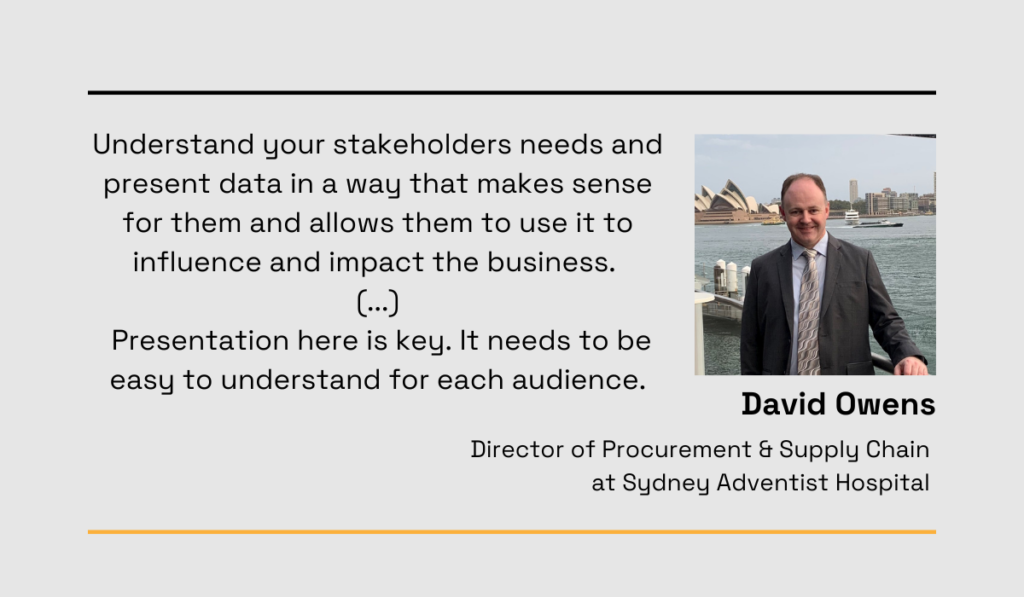How to Make Your Procurement More Data-Driven


Do you often struggle with budget overruns, uncertainty in supplier choices, and poor supplier quality?
These are common issues faced by procurement teams that haven’t yet embraced data-driven practices.
But what exactly is data-driven procurement?
In essence, it’s about relying on analytics to make more informed decisions, whether it’s about sourcing suppliers, managing risks, or negotiating with suppliers for better terms.
Relying on the relevant data can significantly improve your procurement, and with it, the overall profitability of your business.
In this article, we will guide you through four straightforward steps to achieve this.
So, If you’re interested in learning how to transition your procurement to a more data-driven process, we invite you to read further.
The first step in making your procurement more data-driven is to figure out what data you need the most.
Procurement data includes various types of information, such as purchase requisitions, supplier details, purchase orders, invoices, payments, shipment data, and much more.
While all of this data is valuable, having too much information can overwhelm both you and your teams instead of helping make faster and more efficient decisions.
So, before diving into analysis, you have to know why you need data.
In other words, you must determine what specific goals you want to achieve through its use, so you can filter the information you need.
Some common objectives include:

Source: Veridion
The essence of data-driven procurement is to help you achieve these goals.
However, the more specific your objectives, the more efficiently you can use data and see faster results.
Therefore, it’s wise to set SMART (Specific, Measurable, Achievable, Relevant, Time-bound) goals instead of only general ones.
For example, suppose your goal is to reduce the average processing time for purchase requisitions by 20% within the next quarter. This is a SMART goal—let’s break it down:
| Specific | You’re focusing on reducing processing time for purchase requisitions by a specific number (20%). |
| Measurable | Progress can be tracked by monitoring the time from requisition submission to approval and procurement. |
| Achievable | It’s possible to achieve this by implementing process automation for approval workflows and providing procurement staff with training to reduce processing time. |
| Relevant | Faster processing leads to quicker access to necessary goods and services, enhancing operational efficiency. |
| Time-bound | The goal is set for the next three months. |
After defining such objectives for your procurement, the next step is to scrutinize your existing data.
You should determine whether you already have information that can assist in achieving your objectives.
For the specific goal we gave above, you would have to search for information on current processing times, bottlenecks in the requisition process, historical requisition data, and any relevant metrics or KPIs.
You can find this data within your company’s procurement records and systems, such as purchase order logs, workflow tracking, and employee feedback.
In other words, the data you need might already exist within your organization, but without defining a SMART goal, you won’t know what to look for.
However, when your existing data is insufficient or outdated, or when you set goals that require different, specific information that isn’t available within your organization, you must turn to external data sources.

Source: Veridion
Let’s say your objective was to minimize supplier risk.
In addition to examining your internal data (like contracts, cost-related information, and quality control data), it’s essential to have access to fresh data showing changes in a supplier’s business activity.
This would enable you to identify potential risks and ultimately minimize them.
This naturally raises one crucial question—how can you access this external information easily and quickly?
The answer lies in using procurement software, which is the topic of our next section.
The easiest and most convenient way to collect data for procurement is by using an automation tool—procurement software.
Let’s explain how this can make your procurement more data-driven.
Usually, the most time-consuming part of data analysis is not the analysis itself, but the collection of data that precedes it.
As we mentioned earlier, your company already possesses some of this data, but it’s likely scattered across multiple systems, or even buried in Excel spreadsheets.
Gathering it all can be incredibly time-consuming, resource-intensive, and requires manual processes.
In fact, research by Ivalua showed that procurement experts spend more than 30% of their time on manual processes, diverting them from more strategic work.
What’s more, for 67% of procurement professionals, the lack of digitization limits their ability to gain insights into spending and supplier management.

Illustration: Veridion / Data: Ivalua
Hence, the need for procurement software that can automatically collect data from various sources becomes evident, as it can provide valuable insights into both spending and supplier management.
The latter is the core of procurement, making investing in tools that obtain the most up-to-date and fresh supplier data, arguably the most important aspect of data-driven procurement.
Our AI-powered supplier sourcing enabler, Veridion, does just that.
Veridion offers a global, comprehensive, and regularly updated supplier database that becomes available to you in a matter of seconds.

Source: Veridion
Your procurement team won’t have to waste more than a third of their time searching for suppliers. Instead, Veridion will swiftly and accurately do the job, affording your team more time for strategic work.
Beyond its speed and data accuracy, this tool can provide specific insights that help you not only discover the right suppliers but also mitigate supplier risks and make more sustainable decisions.
Whether you’re searching for specific products, services, or suppliers that align with ESG goals, Veridion’s complex search API allows you to discover suppliers based on these criteria.

Source: Veridion
And if you already have some supplier data stored internally, Veridion can enrich it, providing you with a more comprehensive view of your potential partners.
In a nutshell, making your procurement more data-driven is achievable by obtaining accurate data quickly and efficiently.
And the right procurement solution can give you access to such data in a matter of seconds.
Data on its own doesn’t mean much—it’s what we make of it.
So, once you’ve defined your procurement goals and gathered both internal and external data, it’s time to analyze it.
This step is pivotal because analyzing your procurement data is the key to uncovering cost-saving opportunities, enhancing efficiency, and cultivating stronger supplier relationships.
Data analysis unfolds through four distinct stages.

Source: Veridion
The first is descriptive analysis.
This initial stage involves dissecting historical data to describe past procurement patterns and trends. It answers the question: “What happened?”
Next is diagnostic analysis.
Here, you investigate the “why” behind past events, uncovering the root causes of procurement outcomes.
Predictive analysis peeks into the future by studying historical data. It offers valuable foresight into potential procurement challenges and opportunities.
The final and most complex, prescriptive analysis, merges predictive data with optimization. It suggests actionable steps to achieve the best outcomes for your procurement processes.
However, just analyzing data is not enough.
The next, equally important step, is presenting your findings to other people and enabling them to understand it fully.
The culmination of making your procurement processes more data-driven involves sharing the gathered and analyzed data with your stakeholders.
This includes stakeholders at every level of your organization—from your procurement team members to the board of directors.

Source: Veridion
For example, your in-house procurement professionals need data to make informed decisions, optimize processes, and negotiate with suppliers effectively.
The finance department needs insights into spending patterns, cost-saving opportunities, and budget allocations to ensure financial health.
Leaders of various departments require data related to their specific procurement needs and spending to make strategic decisions.
Moreover, sharing certain data with suppliers can strengthen relationships, promote transparency, and aid in joint problem-solving.
Finally, for procurement to be fully data-driven, you have to share this information with high-level decision-makers who rely on data to assess the overall health of procurement processes and their alignment with company objectives.
All in all, the importance of sharing data with all these stakeholders cannot be overstated.
But, to be truly valuable, data must be accessible and easily understandable for every stakeholder.
As David Owens, Procurement and Supply Chain Leader, rightly points out, it’s crucial to present data in a way that will be understandable to each stakeholder.

Illustration: Veridion / Quote: Linkedin
This can be achieved by transforming data into visual aids, such as charts and graphs.
Visualization can transform complex data into easily digestible visuals, enabling people to spot risks and opportunities more clearly.
For instance, a pie chart like the one shown below illustrates how total spending is distributed among various categories or suppliers.

Source: Veridion
However, the choice of visuals should vary for different stakeholders, too.
If addressing the financial department, you can use detailed charts and graphs that delve into specific financial metrics.
For example, bar charts for cost breakdowns and line graphs for revenue trends could be effective.
On the other hand, for the board of directors, you should opt for more strategic and visuals focused on the big picture.
Summary dashboards or high-level infographics that emphasize key insights without overwhelming details could be more appropriate for them.
Presenting data through this approach will make sure that your stakeholders not only understand the data but also feel empowered to leverage it for their respective purposes.
In essence, the key is making the data readily available and digestible for all stakeholders, allowing them to use it to make informed decisions on all levels of the company.
The four steps we explained in this article provide a straightforward approach to making your procurement process more data-driven.
Let’s recap.
The first step is identifying your data needs, which requires setting clear procurement goals and identifying data sources—internal and external.
The next step involves the use of procurement software to obtain data, primarily focusing on acquiring current and up-to-date information about suppliers from external sources such as big data platforms.
Once you have completed these steps, you can analyze the data and transform it into visual insights that you can share with all your stakeholders.
Approaching your data this way will equip you to make better and more informed decisions, which will, ultimately, improve your procurement process, minimize procurement risks, and reduce costs.